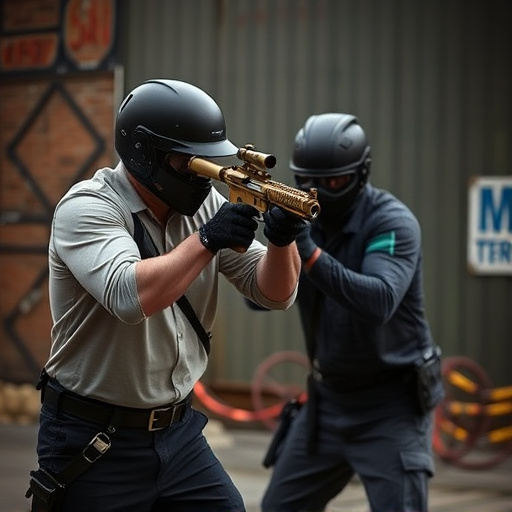To maintain stun gun battery life, regularly charge using recommended intervals and chargers, store in cool, dry conditions away from sunlight and extreme temps, inspect for damage or corrosion, monitor battery levels, avoid overcharging, and periodically test under controlled conditions. Replace batteries after 300-500 cycles.
Personal defense is a serious matter, and understanding your stun gun’s electrical discharge system is key. This guide dives into the essential aspects of managing your stun gun battery life, offering insights on its inner workings and practical tips for optimal performance. From basic battery knowledge to charging practices, learn how to ensure your stun gun remains reliable when you need it most. Discover effective strategies to maintain a sturdy battery life, enhancing your personal safety arsenal.
- Understanding Stun Gun Battery Basics
- Factors Affecting Battery Life
- Effective Charging Practices
- Maintaining Optimal Performance
Understanding Stun Gun Battery Basics

Stun guns, also known as electronic control devices (ECDs), rely on a powerful battery to deliver an electric shock and disable an attacker. Understanding how to maintain the stun gun battery life is crucial for ensuring its reliability when you need it most. Regular charging is essential; follow the manufacturer’s guidelines for recommended charging intervals, typically every 3 to 6 months, depending on usage frequency and battery type.
Proper storage plays a significant role in prolonging battery life. Keep your stun gun charged but unused in a cool, dry place, away from direct sunlight or extreme temperatures. Avoid leaving it in a car, as temperature fluctuations can negatively impact the battery’s health. Additionally, regularly inspect the device for any signs of damage or corrosion, as these can compromise its performance and reduce battery life expectancy.
Factors Affecting Battery Life

Maintaining the battery life of a personal defense weapon, such as a stun gun, involves several key factors. First, understanding the specific battery type is crucial; different batteries have varying lifespans and charging requirements. Lithium-ion batteries, common in modern stun guns, offer superior energy density but may require specialized care to prevent overcharging or deep discharge, which can reduce their overall lifespan.
Regular usage also significantly impacts battery life. Frequent use will necessitate more frequent charging, while occasional users might notice longer battery durations. Environmental conditions play a role too; extreme temperatures, both hot and cold, can affect battery performance and longevity. Therefore, proper storage in moderate temperatures and avoiding prolonged exposure to harsh elements is essential for optimal stun gun battery maintenance and extended service life.
Effective Charging Practices

Proper charging practices are essential for maintaining the stun gun battery life. To ensure optimal performance, always use a dedicated charger designed specifically for your stun device. Avoid overcharging by following the manufacturer’s guidelines and disconnecting the charger once the battery is fully charged. Using incompatible chargers or overcharging can lead to damage or even render the battery useless.
Regularly checking the battery level and replacing it when necessary is crucial. Stun guns with rechargeable batteries should be utilized within the recommended charge cycle, typically between 300-500 discharge-recharge cycles. Proper storage also plays a vital role in extending battery life. Store your stun gun in a cool, dry place away from direct sunlight and extreme temperatures to prevent premature battery degradation.
Maintaining Optimal Performance

To ensure optimal performance from your personal defense weapon, such as a stun gun, proper battery maintenance is paramount. Stun guns rely on high-voltage, low-amperage batteries, which can drain quickly during use. Regularly inspect your device’s battery compartment for any signs of corrosion or damage. Corrosion can significantly reduce battery life and even hinder the stun gun’s ability to discharge properly. Keep the contact points clean and free from debris by using a soft cloth or brush designed for this purpose.
How you store your stun gun is also crucial. Avoid leaving it in extreme temperatures, as both heat and cold can degrade the battery over time. Ideally, store it in a cool, dry place away from direct sunlight. Additionally, consider purchasing a spare battery to ensure you’re always prepared. Regularly testing your stun gun and its batteries under controlled conditions will help maintain peak performance when it matters most.
Personal defense weapons, such as stun guns, rely heavily on their batteries for effectiveness. By understanding the basics of stun gun battery operation, recognizing factors that affect battery life, and adopting effective charging practices, you can ensure optimal performance when it matters most. Regular maintenance and adherence to best practices will help maximize your stun gun’s battery life, ensuring you’re always prepared and ready to protect yourself. Remember, a well-maintained stun gun is a reliable personal defense tool that can provide peace of mind and enhanced safety.
